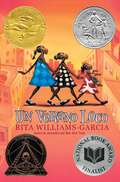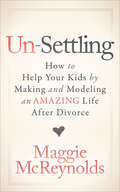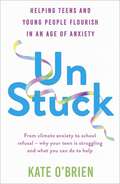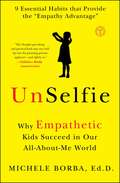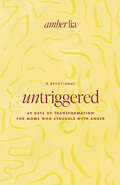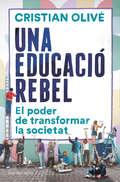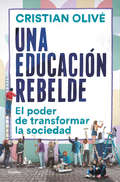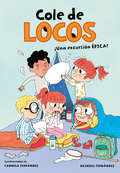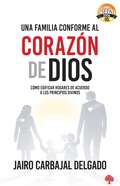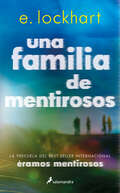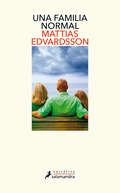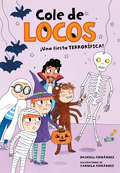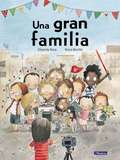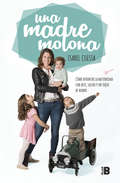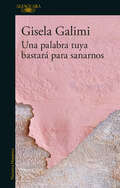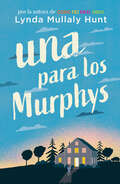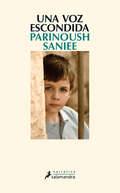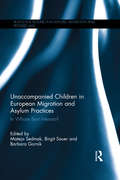- Table View
- List View
Un regalo para papá (¡Arriba la Lectura! Level D #63)
by Elsie Nelley Elise HurstNIMAC-sourced textbook <p><p> Manu y su mamá están en la tienda de juguetes. El juguete que buscan no es para Manu. ¿Para quién será?
Un verano en Villa Fe: La hora más oscura de la noche es justo la que precede al amanecer
by José L. NavajoUn verano inesperado, lejos de la seguridad de la casa de sus padres, se torna en la aventura más significativa en la vida de un niño. Durante las caminatas con su abuelo por los bosques de Villa Fe admirando un lago, atardeceres, árboles, aves y plantas, el chico descubre tanto la creación como la genuina devoción a Dios. Las sabias conversaciones con sus abuelos marcaron su corta existencia a través de mensajes trascendentales como:"Con la fe, las dos opciones que nos ofrece la vida no son ganar o perder, sino ganar o aprender"."Deja que tu fe sea más grande que tus miedos"."La fe convierte el peligro en oportunidad y la situación más adversa en productiva enseñanza".Explore la naturaleza con este niño y sus abuelos. Enriquezca su viaje por la vida y halle sus propias respuestas, mientras disfruta de la novela Un verano en Villa Fe.
Un verano loco: One Crazy Summer (Spanish edition)
by Rita Williams-GarciaThe Spanish-language edition of the beloved Newbery Honor–winning novel about three sisters who travel to Oakland, California, in 1968 to meet the mother who abandoned them, from award-winning author Rita Williams-Garcia! Eleven-year-old Delphine is like a mother to her two younger sisters, Vonetta and Fern. She's had to be, ever since their mother, Cecile, left them seven years ago for a radical new life in California.But when the sisters arrive from Brooklyn to spend the summer with their mother in Oakland, Cecile is nothing like they imagined. While the girls hope to go to Disneyland and meet Tinker Bell, their mother sends them to a day camp run by the Black Panthers.Unexpectedly, Delphine, Vonetta, and Fern learn much about their family, their country, and themselves during one truly crazy summer.This moving, funny novel won the Scott O'Dell Award for Historical Fiction and the Coretta Scott King Award and was a National Book Award finalist.
Un-Settling: How to Help Your Kids by Making and Modeling an Amazing Life After Divorce
by Maggie McReynoldsLearn to create the post-divorce life you want—for you and your kids—with this personal and practical guide to never settling for less. Being a divorced parent is never easy, but it is one of the richest opportunities you&’ll ever have to make bold, life-changing choices about who you are, how you raise your kids, and what kind of example you want to model for them. In Un-Settling, life coach and divorced mom Maggie McReynolds helps you identify where you&’ve settled for less, how to stop, and how to get more out of life for you and your children. With the wisdom of personal experience, Maggie shares advice on how to: * Get past guilt, get over grudges, and get rid of the emotional yuck that&’s holding you back * Find the balance between being your kid&’s best friend and your home&’s sole disciplinarian * Establish healthy boundaries and reliable lines of communication with your ex * Leverage the life hacks and secrets of divorced moms who play life on a big scale * And much more!
Un: Helping Teens and Young Adults Flourish in an Age of Anxiety
by Kate O’BrienEvery child is born a physical, emotional and spiritual being. As parents and caregivers, it is our role to nurture these qualities and help young people mature into confident embodied adults and responsible custodians of our communities, economies and the Earth. But as the scaffolding of the old world has crumbled, we know that many members of Gen Z are experiencing anxiety, depression, addiction and even suicidality at epidemic levels. We want our children to grow up in an environment where they feel safe, loved, and can enjoy a deep sense of belonging. The sensitive, the open-hearted and empathetic ones are the most affected and these are the very people we need most in society.With contributions and timely solutions from leading scientists, doctors, inspirational teachers, visionaries and wisdom holders from varying traditions, the stories of hope in UN:Stuck offer guidance that will help our children mature into confident embodied adults packed with empathy, curiosity and a real sense of playfulness. The chapter titles in this book are rungs on a ladder of hope: Awakened Awareness, Emotional/Ethical intelligence, Interrelatedness (Ukama), Ethical Activism, Meaning & Purpose, Resilience/Courage/Curiosity, Creativity and Inclusion/The Whole Being.The result is a truly 360° vision of how we can support our young people, based on storytelling and wisdom in a way that reconnects them at a fundamental level with their world and seeds hope for the future.
Un: Helping Teens and Young Adults Flourish in an Age of Anxiety
by Kate O’BrienEvery child is born a physical, emotional and spiritual being. As parents and caregivers, it is our role to nurture these qualities and help young people mature into confident embodied adults and responsible custodians of our communities, economies and the Earth. But as the scaffolding of the old world has crumbled, we know that many members of Gen Z are experiencing anxiety, depression, addiction and even suicidality at epidemic levels. We want our children to grow up in an environment where they feel safe, loved, and can enjoy a deep sense of belonging. The sensitive, the open-hearted and empathetic ones are the most affected and these are the very people we need most in society.With contributions and timely solutions from leading scientists, doctors, inspirational teachers, visionaries and wisdom holders from varying traditions, the stories of hope in UN:Stuck offer guidance that will help our children mature into confident embodied adults packed with empathy, curiosity and a real sense of playfulness. The chapter titles in this book are rungs on a ladder of hope: Awakened Awareness, Emotional/Ethical intelligence, Interrelatedness (Ukama), Ethical Activism, Meaning & Purpose, Resilience/Courage/Curiosity, Creativity and Inclusion/The Whole Being.The result is a truly 360° vision of how we can support our young people, based on storytelling and wisdom in a way that reconnects them at a fundamental level with their world and seeds hope for the future.
UnSelfie: Why Empathetic Kids Succeed in Our All-About-Me World
by Michele BorbaBestselling author Michele Borba offers a 9-step program to help parents cultivate empathy in children, from birth to young adulthood--and explains why developing a healthy sense of empathy is a key predictor of which kids will thrive and succeed in the future.Is the Selfie Syndrome Undermining Our Kids' Future? Teens today are 40 percent less empathetic than they were thirty years ago. Why is a lack of empathy--which goes hand-in-hand with the self-absorption epidemic Dr. Michele Borba calls the Selfie Syndrome--so dangerous? First, it hurts kids' academic performance and leads to bullying behaviors. Also, it correlates with more cheating and less resilience. And once children grow up, a lack of empathy hampers their ability to collaborate, innovate, and problem-solve--all must-have skills for the global economy. In UnSelfie Dr. Borba pinpoints the forces causing the empathy crisis and shares a revolutionary, researched-based, 9-step plan for reversing it. Readers will learn: -Why discipline approaches like spanking, yelling, and even time-out can squelch empathy -How lavish praise inflates kids' egos and keeps them locked in "selfie" mode -Why reading makes kids smarter and kinder -How to help kids be Upstanders--not bystanders--in the face of bullying -Why self-control is a better predictor of wealth, health, and happiness than grades or IQ -Why the right mix of structured extracurricular activities and free play is key for teaching collaboration -How to ignite a Kindness Revolution in your kids and community The good news? Empathy is a trait that can be taught and nurtured. Dr. Borba offers a framework for parenting that yields the results we all want: successful, happy kids who also are kind, moral, courageous, and resilient. UnSelfie is a blueprint for parents and educators who want to kids shift their focus from I, me, and mine...to we, us, and ours.
UnTriggered: 60 Days of Transformation for Moms Who Struggle with Anger
by Amber LiaAmber Lia&’s deepest desire was to be a good mom. But frustrations and anger often undermined her mothering. She was overwhelmed and recurringly triggered. Along with anger, she felt shame and discouragement.But she was not alone. When she agreed to start an online group for moms with similar parenting triggers, she quickly discovered that thousands of moms felt just like her. Thank God He is able to restore weary hearts.In UnTriggered, Amber shares encouragement for every mom longing for freedom from anger and the self-condemnation that often accompanies it. This sixty-day devotional touches on heart issues like releasing comparison with other moms, becoming a results-free mom, resisting comparison of children, gaining confidence in listening to the Holy Spirit, embracing the gift of motherhood, and more. Packed with spiritual encouragement, UnTriggered also includes easy &“put it into practice&” steps.Your heavenly Father parents you with tenderness and patience. We can grow to be like Him. Join Amber Lia in this daily journey of releasing your anger and becoming a gentle, biblical parent. You can experience transformation and become untriggered.
Una Llamada de Alerta: Mujer al Borde de una Crisis (Mujer Encadenada Libro 2 #2)
by Mary KingLa policía está frente al escondite de Emelisa. La certeza de su detención le produce cierto alivio. Emelisa conoce el castigo por su delito. Pero se pregunta por qué se siente tan aliviada y por qué los vecinos que la miran con la boca abierta no le dan vergüenza pública. Incluso con las cadenas después en su celda de aislamiento, Emelisa se siente libre como nunca lo ha sido en la vida. Pero su problema más difícil hasta ahora es la policía, que quiere utilizar la tortura emocional para obtener resultados dramáticos. Ella sabe por qué: les ha echado en cara su valor y el orgullo de ser mujer. Sin embargo, no sabe si podrá resistir su tortura.
Una canción de Navidad
by Divino B'AtistaATENCIÓN: Para aquellos que se consideran "lectores fieles" una pequeña advertencia: por favor no lean este especial de Navidad sin haber leído antes el libro "En el último volumen". Por el simple hecho de que los pequeños detalles no serán absorbidos como se esperaba, y también para una mejor percepción de los acontecimientos, ya que este pequeño relato ocurre después del "capítulo final" y mucho antes del "epílogo".
Una chica judía en París
by Melanie LevensohnInspirada en hechos reales y ambientada en el contexto de la Segunda Guerra Mundial Una chica judía en París es una poderosa novela sobre el amor prohibido PARÍS, 1940. La ciudad está bajo ocupación alemana. Una joven judía, Judith, conoce a un joven, hijo de un rico banquero y simpatizante de los nazis; su familia nunca aprobará a la chica de la que se ha enamorado. A medida que los alemanes imponen másy más restricciones a los judíos parisinos, la pareja planea huir del país en secreto. Pero antes de que puedan escapar, Judith desaparece… MONTREAL, 1982. Poco antes de su muerte, Lica Grunberg le confiesa a su hija que tiene una media hermana mayor, Judith. Lica escapó de los nazis, pero perdió todo contacto con su primogénita. Su hija promete encontrar a la hermana que nunca conoció. La búsqueda languidece durante años, hasta que Jacobina es alentada por su joven amiga Béatrice. Pronto las dos mujeres descubren un oscuro secreto familiar, que se extiende por dos continentes y seis décadas, que cambiará sus vidas para siempre. La crítica dice: «En esta novela vívida y conmovedora sobre destinos entrelazados y el poder perdurable del amor contra las peores probabilidades, Levensohn teje una historia saturada de precisión histórica y, sin embargo, sorprendentemente íntima. Una chica judía en París ofrece romance e intriga de sobra, pero el verdadero poder de la novela radica en su descripción de cuán profunday, a veces, misteriosamente podemos encontrarnos conectados con el pasado y entre nosotros.» Paula McLain, autora bestseller de The New York Times con The Paris Wife y When the Stars Go Dark
Una educació rebel: El poder de transformar la societat
by Cristian OlivéUna escola per construir el futur. En educació, anar a contracorrent no és una simple actitud; ser rebels és una convicció per caminar cap a la societat que volem. Un dia, de sobte, vam decidir deixar de situar el focus en l'objecte d'estudi i vam posar-lo en els joves, els autèntics protagonistes del procés d'aprenentatge i del canvi. I aleshores vam entendre que, perquè els joves fossin els autèntics protagonistes, també calia fer un gir en el nostre paper com a docents, com a famílies i com a societat. Un profe rebel pot canviar una aula, però una educació rebel que inclogui a tothom, sense excepcions, pot transformar el món. Aquest és el repte.
Una educación rebelde: El poder de transformar la sociedad
by Cristian OlivéUna escuela para construir el futuro. En educación, ir a contracorriente no es una simple actitud; ser rebeldes es una convicción para caminar hacia la sociedad que queremos. Un día, de pronto, decidimos dejar de situar el foco en el objeto de estudio y lo pusimos en los jóvenes, los verdaderos protagonistas del proceso de aprendizaje y del cambio. Y entonces comprendimos que para que los jóvenes fueran los verdaderos protagonistas también era necesario dar un giro en nuestro papel como docentes, como familias y como sociedad. Un profe rebelde puede cambiar un aula, pero una educación rebelde que incluya a todos sin excepción puede transformar una sociedad y lograr un futuro mejor. Ese es nuestro reto.
Una excursión épica (Cole de locos #Volumen 2)
by Dashiell Fernández Pena¡Ya está aquí el cole más loco, una divertida serie de primeras lecturas sobre la escuela, la familia y los amigos! La pandilla más gamberra, bromista y chiflada está lista para la próxima aventura. ¡Un a-lu-ci-nan-te campamento en el bosque! ¿Se te ocurre un plan más divertido? Lucas, Asim, las gemelas y Carlos están dispuestos a pasarlo en grande. Se imaginan un campamento repleto de juegos y diversión, pero todo da un giro inesperado cuando oyen hablar de la leyenda de la niña desaparecida en el bosque... ¿Lograrán descifrar el misterio de la niña perdida?
Una familia conforme al corazón de Dios: Cómo edificar hogares de acuerdo a los principios divinos
by Jairo Carbajal¿Existe algún modelo que podamos seguir para construir hogares sólidos y sanos? En este libro, Jairo Carbajal expone con entendimiento extraordinario y buen juicio los principios bíblicos que se necesitan para edificar nuestras familias de acuerdo al orden de Dios. Carbajal, quien biene más de 30 años de experiencia ministerial, traza con maestría su conocimiento de la Biblia con sus propias experiencias y las de otros. Una familia conforme al corazón de Dios es un libro superior que contesta las preguntas y dudas de padres y madres. Ya seas soltero o casado, tu familia es parte importante de la obra que Dios está haciendo hoy. DIos está levantando familias fuertes y victoriosas. No te conformes con nada menos.
Una familia de mentirosos
by E. LockhartVuelven los Sinclair, la familia de mentirosos que ha revolucionado Booktok Una isla privada azotada por el viento frente la costa de Massachusetts. Un océano hambriento, repleto de secretos y tristeza. Una heredera apasionada y adicta. Un chico irresistible e impredecible. Un verano de traiciones imperdonables y errores terribles.Bienvenida de nuevo a la familia Sinclair. Siempre fueron mentirosos.
Una familia normal
by Mattias EdvardssonSi la policía acusa a tu hija de asesinato, ¿hasta dónde llegarías para mantener unida a tu familia? Adam y Ulrika, un matrimonio normal, viven con su hija Stella, de dieciocho años, en una zona agradable en las afueras de Lund. En apariencia, su vida es perfecta... hasta que un día dicha ilusión se trunca de raíz cuando Stella es arrestada por haber asesinado brutalmente a un hombre casi quince años mayor que ella. Su padre, un respetado pastor de la iglesia sueca, y su madre, una conocida abogada defensora criminal, deberán replantearse su paradigma ético mientras la defienden e intentan comprender por qué es la principal sospechosa del crimen. ¿Hasta dónde llegarán para proteger a su hija? ¿Saben realmente cómo es? Y más preocupante aún: ¿acaso se conocen el uno al otro? La crítica ha dicho...«Un tour de force de lectura obligatoria.»The Wall Street Journal «Un thriller que se lee de forma compulsiva y un fascinante estudio de lo que entendemos por familia.»Schwerter Zeitung «Un brillante thriller psicológico.»Neue Welt «Una novela adictiva [...] que consigue desenmascarar las promesas que nos hacemos a nosotros mismos para ser las personas que nuestros seres queridos esperan que seamos, revelando lo endebles que pueden ser esas pretensiones.»The New York Times «Una novela que cuestiona la verdad, la ley, la justicia y a Dios.»Corriere della Sera «Una novela ingeniosa y fascinante, que nos hará cuestionar todo lo que sabemos de nuestros allegados.»Karin Slaughter «Edvardsson teje con habilidad motivos de culpa y sacrificio de los padres en un delicado drama familiar.»Kirkus Reviews
Una fiesta terrorífica (Cole de locos #Volumen 4)
by Dashiell Fernández Pena¡Nueva aventura del cole más loco, una divertida serie de primeras lecturas sobre la escuela, la familia y los amigos! Cada año el Cole de Locos organiza una fiesta nocturna de Halloween. Es la primera vez que Lucas, Asim, las gemelas y Carlos van a la fiesta. Los mayores de 6º, les han contado que va a ser la noche más horrible que se puedan imaginar. Un túnel del terror, una clase llena de muertos vivientes, una cena repleta de bichos y murciélagos... El grupito va a recibir un montón de sustos ¡te-rro-rí-fi-cos! ¿Estás preparado para acompañarles en esta aventura?
Una gran familia
by Elisenda Roca¡Hola! Soy Violeta. Tengo un perro travieso que se llama Cepillo. Con mis amigos y amigas estamos preparando una fiesta en el barrio. Aquí viven familias muy distintas. Pero hay una cosa que nos hace iguales: todos nos ayudamos y nos queremos. Somos una gran familia. ¿Nos acompañas? <p><p> Por cierto, ¿habéis visto dónde se ha escondido Cepillo?
Una madre molona: Cómo afrontar la maternidad con arte, salero y un toque de humor
by Isabel CuestaCréetelo: ¡tú también eres una madre molona! En esta época llena de cambios y de prisas locas, muchas mujeres viven la maternidad sintiéndose agobiadas, ahogadas, estresadas. Y no es para menos cuando el tiempo no sobra y las críticas no faltan. Isabel Cuesta -la creadora del blog Una madre molona- está convencida de que esto puede cambiar y de que es posible vivir esta etapa con alegría, optimismo y humor. Para ello, basándose en su propia experiencia como madre de tres niños pequeños, aborda todo el recorrido desde que se sabe que un bebé está en camino, pasando por el embarazo, las hormonas, el paritorio, el temido posparto, los primeros meses, la falta de sueño, los celos, la lactancia... hasta la disciplina positiva, que ha marcado un antes y un después a la hora de gestionar rabietas, conflictos y las dificultades del día a día. Un libro repleto de consejos prácticos y, sobre todo, con mucho humor, ya que «si de esto nos reiremos el día de mañana, ¿por qué no empezar ahora?».
Una noche de invierno
by Laura KasischkeAlgo los había seguido a casa desde Rusia. Un thriller oscuro y escalofriante que combina el drama doméstico con el suspense psicológico, una historia adictiva de negación y culpa. Una mañana de Navidad, una mujer hace balance de los trece años transcurridos desde que recogió a su niña en un orfanato ruso. Aunque no es precisamente el día más apropiado para rendir cuentas, el impulso de sincerarse y de enfrentarse a su propia decepción hace que madre e hija se enzarcen en una larga discusión en la que aflora el abismo que las separa. Bajo el fuego cruzado de amargos reproches, el vínculo amoroso, profundo e inextinguible, se presenta como el último recurso para superar la crisis y recomponer la relación. Sin embargo, en una jornada aciaga, mientras una feroz tormenta de invierno se abate sobre la zona, un acontecimiento inesperado condiciona de forma dramática la estabilidad de la familia. El día empieza de forma irregular. Los regalos siguen bajo el árbol, sin abrir, porque Holly y Eric, los padres, se han quedado dormidos después de una noche de excesos. Cuando Tatiana, quinceañera incomprendida, le echa en cara a su madre la actitud irresponsable, Holly, una poetisa marcada por haber renunciado a la escritura, no pierde la ocasión de señalarle todas las carencias que la convierten en una hija ingrata y egoísta. Y mientras Eric se ausenta para recoger a sus padres en el aeropuerto, el clima de tensión va aumentando por momentos. Así, al caer la noche y bajo un manto de nieve que todo lo cubre, Holly se hace las preguntas inevitables: ¿en qué se ha convertido su adorada Tatty? ¿Dónde ha quedado el brillo de sus hermosos ojos negros? ¿Es tan sólo la adolescencia o se trata de una especie de castigo que ha caído sobre la familia? Por desgracia, su angustia y su desesperación parecen ir en consonancia con la terrible verdad que está a punto de descubrir. Reseñas:«Un libro que te persigue durante días y largas, largas noches, después de leerlo.»Booklist Starred Review «Una mañana de una Navidad con ventisca de nieve se convierte en el escenario de una inquietante novela psicológica, en la que la tensión entre una madre y una hija aumenta hasta desencadenar una impactante folie à deux, que hunde sus raíces en un lejano orfanato ruso.»Vogue.com «Laura Kasischke aúna hábilmente la mirada al abismo interior de una mujer dañada con una trama repleta de giros inesperados que desemboca en un final sorprendente.»Publishers Weekly
Una palabra tuya bastará para sanarnos
by Gisela GalimiUna mujer que enfermó de lepra en la adolescencia cuenta su tratamiento y curación, que va en paralelo al descubrimiento de la escritura. Una poderosa reflexión sobre el arte de escribir. «Cuando nombro la lepra la gente se sorprende, me interroga. Nunca sé si sienten miedo o solo curiosidad. Me apuro a decir que estoy totalmente curada, que soy una persona sana [...]. Cada vez comparto con más gente la historia. Hablar es entender. Escribir es curarse.» Cuando contrajo la enfermedad de Hansen, comúnmente conocida como lepra, la autora era una adolescente que tenía una vida feliz, en una ciudad de provincia, con una familia amorosa. Iba a la escuela, jugaba con sus amigos, le gustaba escribir. Sus padres decidieron no contarle que era lepra para protegerla de los prejuicios que todavía hoy persisten en la sociedad. El tratamiento con antibióticos la curó por completo, y no fue hasta que cumplió los veinte años que su médica le informó de qué se trataba. Ese silencio alrededor de la enfermedad, sus consecuencias, es de lo que trata este libro. Y de cómo la escritura es también una manera de sanar. «Una palabra tuya bastará para sanarnos es mucho más que el testimonio de una escritora que en su infancia padeció lepra, esa enfermedad mítica, temida y estigmatizada. Es un libro sobre el amor, el miedo, el silencio, el agradecimiento y, ante todo, sobre lo que Gisela Galimi llama "mi cuerpo propio ajeno a mí"; es también una hermosa reflexión, atravesada por la mirada poética y el humor, sobre la escritura como un camino de liberación, que nos abre la posibilidad de ver más allá de lo que habitualmente vemos.»Piedad Bonnett, autora de Lo que no tiene nombre
Una para los Murphys
by MULLALY HUNT, LYNDADe la autora de la novela bestseller del New York Times, Como pez en el árbol. Carley usa el humor y su inteligencia de la calle para mantener sus muros emocionales altos y gruesos. Pero el día en que entra en adopción temporal y se muda con los Murphy, es como que le cayera un balde de agua fría encima. Esta familia cariñosa y muy activa le muestra a Carley una vida familiar estable que ella nunca pensó podría existir, y se siente como una extraterrestre en ese hogar perfecto. A pesar de su resistencia, los Murphy logran mostrarle cómo se siente pertenecer al núcleo familiar, hasta que un día, su madre decide que la quiere de vuelta con ella y Carley tiene que decidir dónde y cómo vivir. Ella no es realmente una Murphy, pero lo que ellos le han dado le ha abierto un nuevo futuro. “La escritura de Hunt es intrépida y Una para los Murphys es una historia que es a la vez tierna, estimulante y hermosamente contada. Me sumergí en la historia de Carley desde la primera página. Ella es un personaje que no debe perderse ni olvidarse”. — Jacqueline Woodson, autora de Niña morena sueña, obra ganadora del National Book Award. Ganadora del premio Tassy Walden que premia las nuevas voces de la literatura infantil.
Una voz escondida
by Parinoush SanieeBasándose en el caso real de un niño que no habló hasta cumplir los siete años, Parinoush Saniee aborda las aciagas secuelas de la insensibilidad y la ignorancia y toma el pulso a la sociedad de su país, Irán, con una historia en la que el silencio cobra la fuerza de un grito de protesta. A Shahab le encanta mirar cómo brilla la luna en el cielo nocturno, silenciosa, como él, que nunca ha pronunciado una palabra. No se trata de una enfermedad, no es mudo, sencillamente ha decidido que el momento de hablar aún no ha llegado. Cómo es natural, todo el mundo lo considera un niño problemático, incluso menos espabilado que los demás chicos de su edad, y cuando la burla y la animadversión hacen acto de presencia, su padre, Naser, no encuentra ni el tiempo ni las ganas de defender a su hijo ni de entender su mutismo. Así pues, Shahab se encierra en un universo propio del que intentará rescatarlo su madre, Mariam, la única que cree en él, una mujer culta y educada que conoce de primera mano los daños que la incomprensión y la indiferencia pueden infligir a una persona. Día tras día, Shahab irá descubriendo que a veces el camino que lleva al corazón de la gente es largo y tortuoso, pero que, a la postre, la verdad siempre encuentra una forma de quitarse la mordaza y hacer oír su voz. Críticas:«Una ventana abierta al Irán de los últimos cincuenta años.»Corriere della Sera «Una escritora apasionada y rebelde que rompe el silencio de la injusticia.»The Independent «Ni siquiera la censura ha logrado acallar la voz incisiva de esta mujer valiente.»The Guardian «Shahab no es sólo un niño que se enfrenta a una dificultad. Su mutismo es, de hecho, el de una nación entera, aterrorizada por un régimen asfixiante. Es una llamada de atención. Parinoush Saniee sabe cómo hacerla.»The Cultural Supplement «Lo mejor de la novela es que nadie es bueno ni malo. Todos son víctimas de un sistema que los oprime y de su propia mente inconsciente.»Dagbladet «Cuando leí esta novela me di cuenta de lo importante que es el reconocimiento de quienes nos rodean [...]. Si este libro no logra conmoverte, es que eres de piedra.»Familien «Una obra magníficamente escrita en la que Parinoush Saniee hace una crítica del tejido social de Irán, y que a la vez que narra la historia de un niño, retrata también la vida de las mujeres. Diálogos convincentes y un protagonista que se convierte en un símbolo de esperanza de un mundo mejor.»La Repubblica «Una voz escondida es el nuevo fenómeno literario. Las palabras silenciadas de un niño se transforman en un grito contra la crueldad y la indiferencia.»Panorama
Unaccompanied Children in European Migration and Asylum Practices: In Whose Best Interests? (Routledge Research in Asylum, Migration and Refugee Law)
by Mateja Sedmak Birgit Sauer Barbara GornikUnaccompanied minor migrants are underage migrants, who for various reasons leave their country and are separated from their parents or legal/customary guardians. Some of them live entirely by themselves, while others join their relatives or other adults in a foreign country. The concept of the best interests of a child is widely applied in international, national legal documents and several guidelines and often pertains to unaccompanied minor migrants given that they are separated from parents, who are not able to exercise their basic parental responsibilities. This book takes an in-depth look at the issues surrounding the best interests of the child in relation to unaccompanied minor migrants drawing on social, legal and political sciences in order to understand children’s rights not only as a matter of positive law but mainly as a social practice depending on personal biographies, community histories and social relations of power. The book tackles the interpretation of the rights of the child and the best interests principle in the case of unaccompanied minor migrants in Europe at political, legal and practical levels. In its first part the book considers theoretical aspects of children’s rights and the best interests of the child in relation to unaccompanied minor migrants. Adopting a critical approach to the implementation of the Convention of Rights of a Child authors nevertheless confirm its relevance for protecting minor migrants’ rights in practice. Authors deconstruct power relations residing within the discourses of children’s rights and best interests, demonstrating that these rights are constructed and decided upon by those in power who make decisions on behalf of those who do not possess authority. Authors further on explore normative and methodological aspects of Article 3 of the Convention on the Rights of a Child and its relevance for asylum and migration legislation. The second part of the book goes on to examine the actual legal framework related to unaccompanied minor migrants and implementation of children’s’ rights and their best interests in the reception, protection, asylum and return procedures. The case studies are based on from the empirical research, on interviews with key experts and unaccompanied minor migrants in Austria, France, Slovenia and United Kingdom. Examining age assessment procedures, unaccompanied minors’ survivals strategies and their everyday life in reception centres the contributors point to the discrepancy between the states’ obligations to take the best interest of the child into account when dealing with unaccompanied minor migrants, and the lack of formal procedures of best interest determination in practice. The chapters expose weaknesses and failures of institutionalized systems in selected European countries in dealing with unaccompanied children and young people on the move.


